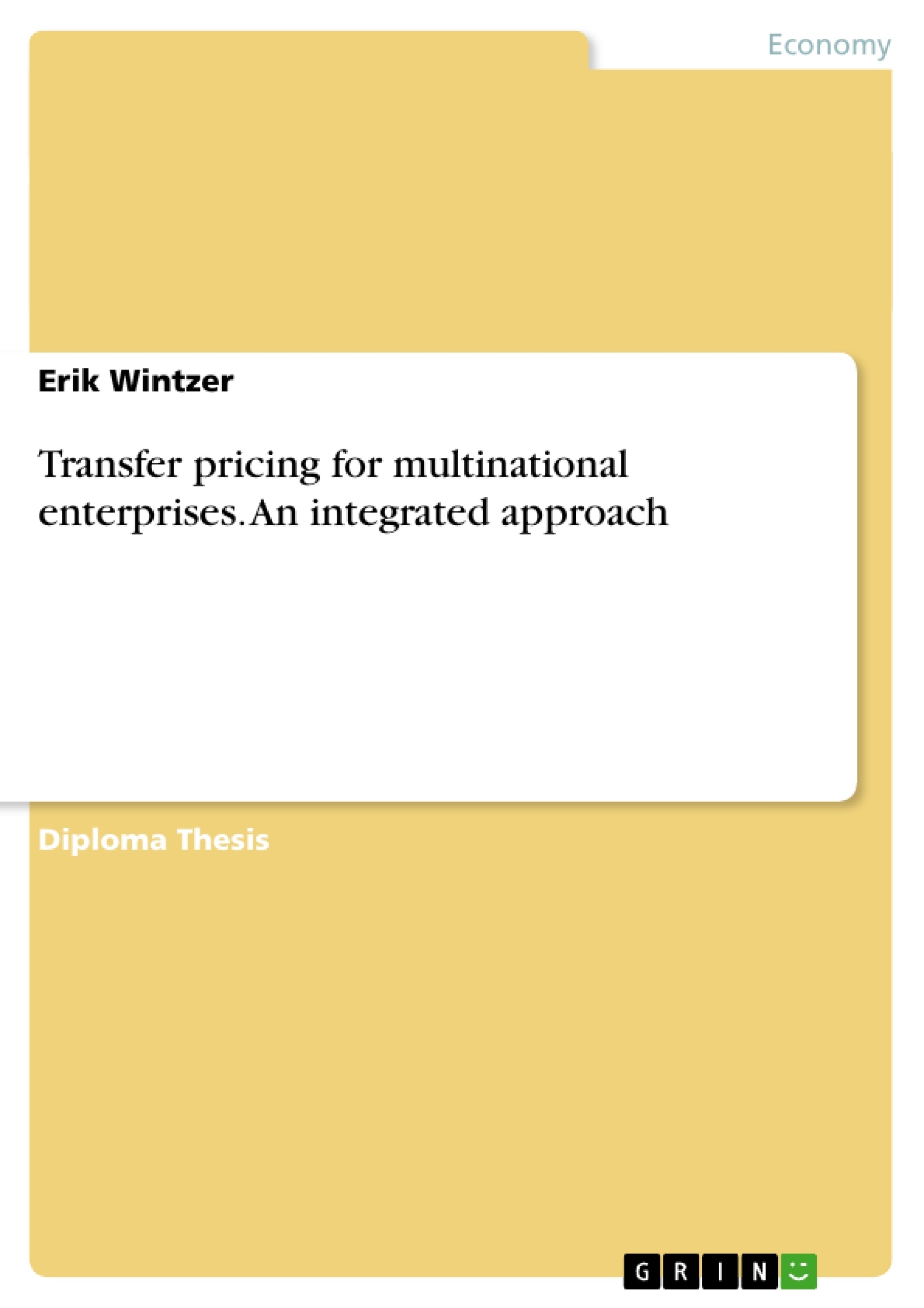
Transfer pricing for multinational enterprises. An integrated approach
Diplomarbeit, 2003
52 Seiten, Note: 2,0 (B)
Leseprobe
Inhaltsverzeichnis (Table of Contents)
- 1 Introduction
- 2 Transfer Pricing and Management Accounting
- 2.1 Functions of Transfer Prices in Management Accounting
- 2.1.1 Coordination
- 2.1.2 Performance Evaluation
- 2.2 Types of Transfer Prices
- 2.2.1 Market-based Transfer Prices
- 2.2.2 Cost-based Transfer Prices
- 2.2.3 Negotiated Transfer Prices
- 3 Transfer Pricing and Strategy
- 3.1 Divisional Strategy Implementation with Transfer Pricing
- 3.1.1 Encouraging Divisional Competitive Position
- 3.1.2 The Enforcement of Retrenchment
- 3.2 Strategic Transfer Pricing
- 3.2.1 The Model of Strategic Transfer Pricing
- 3.2.2 Strategic Transfer Pricing and Observable Transfer Prices
- 3.2.3 Strategic Transfer Pricing and Unobservable Transfer Prices
- 3.2.4 Practical and Theoretical Implications
- 4 Transfer Pricing, Multinational Enterprises, and External Constraints
- 4.1 Transfer Pricing for Tax Accounting The Primary Objective
- 4.1.1 The Organization for Economic Cooperation and Development
- 4.1.2 The Determination of Tax Transfer Prices
- 4.1.3 Thin Capitalization
- 4.2 Transfer Pricing and Secondary External Constraints
- 4.2.1 Import Duties
- 4.2.2 Economic Restrictions
- 4.2.3 Currency Fluctuations
- 4.2.4 Withholding Taxes
- 4.2.5 Outside Shareholders of Specific Divisions
- 4.2.6 Paying Taxes and Public Relations
- 4.3 Transfer Pricing and Governmental Considerations
- 4.3.1 Globalization and Tax Competition
- 4.3.2 Political Structures and Regulations
- 4.4 Integrated Multinational Transfer Pricing Management Accounting, Strategy, and External Constraints
- 4.4.1 The Application of Several Books
- 4.4.2 Taking Advantage of Ranges for Tax Transfer Prices for Other Aspects
- 4.4.3 Mathematical Programming Approaches
- 5 Concluding Remarks
Zielsetzung und Themenschwerpunkte (Objectives and Key Themes)
This paper aims to provide an integrated approach to transfer pricing for multinational enterprises (MNEs), encompassing aspects of management accounting, strategy, and external constraints.
- The functions of transfer prices in management accounting
- The strategic use of transfer pricing in MNEs
- The impact of external constraints on transfer pricing decisions
- The importance of integrating various aspects of transfer pricing for optimal decision-making
- The role of globalization and tax competition in transfer pricing policies
Zusammenfassung der Kapitel (Chapter Summaries)
Chapter 1 introduces the concept of transfer pricing and its significance in the context of globalization and intrafirm trade. Chapter 2 delves into the functions of transfer prices in management accounting, including coordination and performance evaluation. It also examines different types of transfer prices, such as market-based, cost-based, and negotiated prices. Chapter 3 explores the strategic aspects of transfer pricing, focusing on divisional strategy implementation and the model of strategic transfer pricing. It discusses how transfer pricing can be used to encourage competition or enforce retrenchment within divisions. Chapter 4 examines the impact of external constraints on transfer pricing decisions, including tax accounting, import duties, economic restrictions, and currency fluctuations. It also analyzes the role of governmental considerations in shaping transfer pricing policies.
Schlüsselwörter (Keywords)
Transfer pricing, multinational enterprises, management accounting, strategy, external constraints, tax accounting, globalization, tax competition, intrafirm trade, divisional strategy, strategic transfer pricing.
Details
- Titel
- Transfer pricing for multinational enterprises. An integrated approach
- Hochschule
- Hochschule Schmalkalden, ehem. Fachhochschule Schmalkalden (Economics)
- Veranstaltung
- Cost Pricing und Controlling
- Note
- 2,0 (B)
- Autor
- Erik Wintzer (Autor:in)
- Erscheinungsjahr
- 2003
- Seiten
- 52
- Katalognummer
- V10822
- ISBN (eBook)
- 9783638171465
- ISBN (Buch)
- 9783638698108
- Dateigröße
- 518 KB
- Sprache
- Englisch
- Anmerkungen
- Enterprises must overcome many obstacles in introducing transfer pricing mechanisms. This paper analyzes the use of transfer pricing as a device for management accounting, strategy implementation, and dealing with external constraints in divisionalized, vertically integrated, multinational enterprises.
- Schlagworte
- transfer
- Produktsicherheit
- GRIN Publishing GmbH
- Preis (Ebook)
- US$ 19,99
- Preis (Book)
- US$ 29,99
- Arbeit zitieren
- Erik Wintzer (Autor:in), 2003, Transfer pricing for multinational enterprises. An integrated approach, München, Page::Imprint:: GRINVerlagOHG, https://www.diplomarbeiten24.de/document/10822
- Autor werden
- Ihre Optionen
- Vertriebskanäle
- Premium Services
- Autorenprofil
- Textarten und Formate
- Services für Verlage, Hochschulen, Unternehmen

- © GRIN Publishing GmbH.
- Alle Inhalte urheberrechtlich geschützt. Kopieren und verbreiten untersagt.
- info@grin.com
- AGB
- Open Publishing
Der GRIN Verlag hat sich seit 1998 auf die Veröffentlichung akademischer eBooks und Bücher spezialisiert. Der GRIN Verlag steht damit als erstes Unternehmen für User Generated Quality Content. Die Verlagsseiten GRIN.com, Hausarbeiten.de und Diplomarbeiten24 bieten für Hochschullehrer, Absolventen und Studenten die ideale Plattform, wissenschaftliche Texte wie Hausarbeiten, Referate, Bachelorarbeiten, Masterarbeiten, Diplomarbeiten, Dissertationen und wissenschaftliche Aufsätze einem breiten Publikum zu präsentieren.
Kostenfreie Veröffentlichung: Hausarbeit, Bachelorarbeit, Diplomarbeit, Dissertation, Masterarbeit, Interpretation oder Referat jetzt veröffentlichen!
- GRIN Verlag GmbH
-
- Nymphenburger Str. 86
- 80636
- Munich, Deutschland
- +49 89-550559-0
- +49 89-550559-10
- info@grin.com
-









